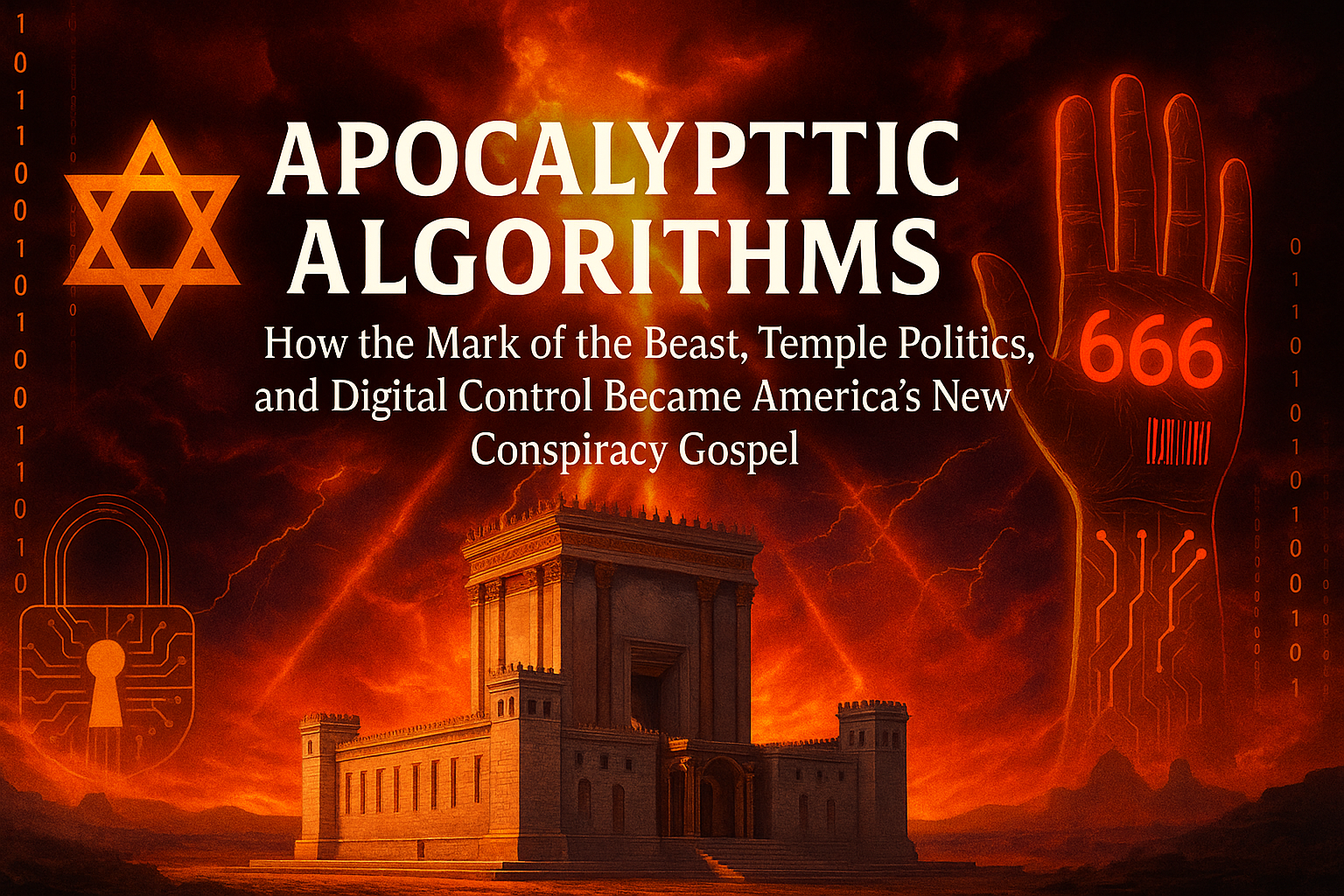In the shadowy corners of the American psyche, a new eschatology is taking root—part prophecy, part paranoia. It fuses Bible verses with blockchain, geopolitics with genetic tracking. At the center of it all are two ancient obsessions: the Mark of the Beast and the rebuilding of the Jewish Temple in Jerusalem.
Together, they form a kind of digital Revelation, a lens through which a growing number of Americans—some devout, others merely disillusioned—are interpreting the chaotic architecture of the modern world.
The Prophecy and the Protocol
The source material is familiar. Revelation 13 warns of a time when no man can buy or sell unless he bears the mark—a number, a name, or a symbol on the hand or forehead. For centuries, theologians and scholars treated it as allegory. But in the 21st century, this cryptic scripture has morphed into a blueprint for conspiracy.
From RFID chips to facial recognition software, from vaccine passports to the looming specter of central bank digital currencies (CBDCs), some see the infrastructure of prophecy under construction. Their fear is not of fiction, but of a rapidly forming system in which obedience is coded, and commerce is conditional.
The Temple Mount and the Algorithm
Then, there’s Jerusalem—the ancient heart of Western spirituality. In particular, the Temple Mount, a contested plateau where the Islamic Al-Aqsa Mosque stands and where some Jews hope to build the long-awaited Third Temple.
That vision is no longer confined to the margins. The Temple Institute, a religious organization based in Israel, has spent years preparing for its construction. It has priestly garments. Sacred vessels. Even a red heifer, the biblical requirement for temple purification, was reportedly bred in Texas and flown to Israel under government supervision.
To believers in biblical prophecy, the rebuilding of the Temple heralds the end of the age. But in the narrative emerging from conspiratorial America, it’s also a geopolitical trapdoor—a pretext for the rise of a global tyrant, often identified as the Antichrist.
Theories Converge: One World, One System
This is where the stories converge—the Beast, the Temple, and the network. The story goes like this:
- A global crisis—pandemic, war, climate collapse—justifies the implementation of digital ID systems, tightly integrated with health, banking, and movement.
- Economic digitization makes it possible to deactivate dissenters with the flick of an algorithm.
- Meanwhile, in the Middle East, a seven-year peace treaty is brokered, allowing for the Temple’s construction.
- A charismatic world leader arises, entering the Temple and proclaiming godhood.
- The Mark of the Beast, once symbolic, becomes literal—embedded in code, enforced by culture, sustained by compliance.
It is a theory that spans from the fringe to the mainstream with alarming speed, fueled by podcasts, YouTube prophets, and shadowy Twitter threads. The actors in this drama are cast broadly—the WEF, WHO, IMF, and Silicon Valley—all woven into a tapestry of technocratic domination.
Apocalypse as Political Language
To understand the surge of this belief system is not merely to decode its logic, but to witness its emotional terrain.
What’s spreading isn’t just a theory. It’s a narrative architecture, a new sacred story in an age where institutional trust is crumbling. It offers moral clarity in a world defined by ambiguity. It turns QR codes into seals of damnation and elevates data privacy into a religious imperative.
Among evangelicals, libertarians, and post-pandemic skeptics, the “Beast System” has become a metaphor for everything: inflation, AI, censorship, and even ESG policies. And it’s not just religious. Many adherents no longer identify with churches but find spiritual fuel in online communities that function more like digital monasteries than forums.
Between Jerusalem and Silicon Valley
In private briefings with security officials and interviews with technologists, one finds little appetite for apocalyptic thinking. “This is governance,” one diplomat told me. “Not Revelation.” But the perception gap is real—and dangerous.
A red heifer in Israel might be viewed by a rabbi as a prophetic milestone, while to a tech-savvy doomsayer in Texas, it’s the starter pistol for the Tribulation. A World Bank pilot program in digital currency becomes, to some, the economic chainsaw of Revelation 13.
What matters is not only what is happening—but what people believe is happening. In this new theology of control, the sacred and the algorithmic have merged.
Where This Leads
Whether one sees it as prophecy fulfilled or hysteria misplaced, the framework now exists. There are real-world implications: policy influenced by paranoia, rising political violence, and digital systems that—whether by design or misuse—can indeed silence dissenters.
We live in an era where theological symbols are becoming UX patterns. And in the background, the line between governance and godhood, commerce and control, is quietly fading.
As one source, a retired intelligence analyst with roots in evangelical theology, told me:
“If you think this is just about chips or barcodes, you’re missing the point. It’s about who gets to define truth in a world where control is invisible.”
The mark, it seems, may not arrive as a chip or a tattoo.
It may come as an update.








%20(3).png)
.png)